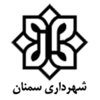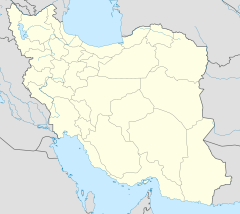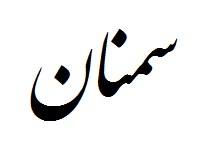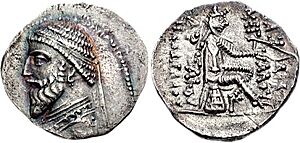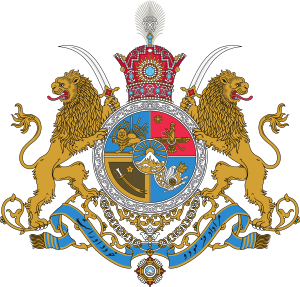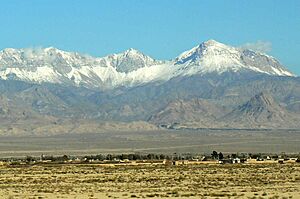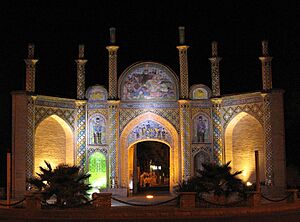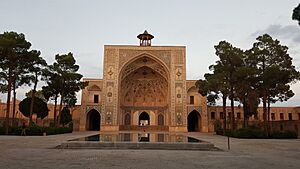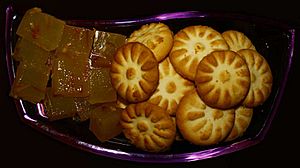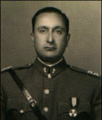Semnan, Iran facts for kids
Quick facts for kids
Semnan
سمنان، سَمَن
also known as Saman
|
||
|---|---|---|
|
City
|
||

Imam Soltani mosque
|
||
|
||
| Nickname(s):
City of Compassion
|
||
| Motto(s):
Welcome; خوش امیچین
|
||
| Country | Iran | |
| Province | Semnan | |
| County | Semnan | |
| District | Central | |
| Settled | circa 240BCE by Parni tribesmen | |
| Incorporated (city) | 1926 | |
| Government | ||
| • Type | Municipality | |
| Elevation | 1,130 m (3,707 ft) | |
| Population
(2016)
|
||
| • Total | 185,129 | |
| Time zone | UTC+3:30 (IRST) | |
| Area code(s) | +98 23 | |
| Main Languages | Persian, Semnani | |
| Climate | BWh | |
Semnan (Persian: سمنان; pronounced [semˈnɒːn]) is a city in Iran. It is the capital of Semnan Province and Semnan County. The city is located in the north-central part of Iran. It is about 216 kilometers (134 miles) east of Tehran, the capital of Iran.
Semnan is the largest city in its province, with over 185,000 people in 2016. It is known for the Semnani language, which is a local language spoken by the Semnani people. The city offers many fun things to do, like visiting historical places and religious sites. It also has festivals, beautiful gardens, and parks. Semnan is an important center for culture and politics in its province. Some popular souvenirs from Semnan include daffodil flowers, special pastries like Shirmal and Kolüçe cookies, and traditional kilim rugs.
Contents
- What's in a Name? The History of Semnan's Name
- Semnan Through Time: A Journey Through History
- People of Semnan: Language and Culture
- Semnan's Location and Weather
- Exploring Semnan: Historical Sites and Places to See
- Semnan's Economy: Industry and Farming
- Semnan's Traditions and Customs
- Semnan's Unique Foods
- Semnan's Culture: Poetry and Stories
- Media in Semnan
- Getting Around Semnan: Transportation
- Learning in Semnan: Higher Education
- Famous People from Semnan
- Images for kids
- See also
What's in a Name? The History of Semnan's Name
People have different ideas about where the name Semnan came from. Here are a few theories:
- Some believe Semnan was an ancient city where people worshipped idols. Their religion was called samīna, which might have given the city its name.
- Another idea is that the city was founded by the Scythians, an ancient Iranian group. They might have called their settlement Sakanān.
- Local stories say that the first settlers were two of Prophet Noah's children, Sim An-Nabi and Lam An-Nabi. Their settlement was called Simlam, which later changed to Semnan.
- A mythical character named Tahmuras is also thought to have founded the city and named it Saminā.
- The name might come from an old local language called Sa ma nān. The city then took the name of its people's language.
- One theory suggests the name means 'three months of bread' in a changed Persian way. This comes from a tradition where Semnani women would bake enough bread for three months in one day.
Semnan Through Time: A Journey Through History
Ancient Times: Before Islam
Semnan has a very long history. It was one of 14 important places in an ancient province called "Vern." The city remained important during the time of the Achaemenid Empire in Persia.
After Alexander the Great conquered Persia, the area around Semnan became known as Komesh. The city really started to grow when the Arsacid dynasty of Parthia came to power. The Parthians were an Iranian group who liked to bring in Greek culture. This led to new art forms like sculpting in Semnan. One of the Parthian Empire's capital cities, Hecatompylos, was located near modern Semnan.
When the Parthian Empire fell, the Sassanid Empire took over. They made Zoroastrianism the main religion. Semnan then returned to traditional Persian ways.
After Islam: New Eras
After the Muslim conquest of Persia, Islam became the main religion in Semnan. At first, people practiced Sunni Islam, like most of early Islamic Persia. However, the Alavids from Tabaristan, who followed a different branch of Islam called Shi'a Islam, conquered Semnan. They brought the Zaidi Shi'a sect to the city.
Later, in 1036 CE, the Seljuq Turks invaded and caused a lot of damage. But these same Turks also built many historical buildings and roads in Semnan. As the Seljuq Empire weakened, the Abbasids took control. The people of Semnan faced hard times under the Abbasid Caliphate. Some say that because the Abbasids used black flags, the people of Semnan still dislike the color black today.
The Abbasid rule ended when the Mongols invaded in 1221 CE. The Mongols destroyed much of the city and killed many people. Semnan did not recover until the Turco-Persian Safavid dynasty rose to power. The Safavids brought the Twelver Shi'ism sect of Islam to Semnan. They also helped rebuild the city.
The Qajar Era: Growth and Trade

Under the Qajar dynasty, Semnan saw a lot of progress in its economy, culture, and buildings. The Qajars made Semnan a strong city. It was an important stop on the main trade route between their capital, Tehran, and the holy city of Mashad.
Wealthy Qajar royals built their homes in Semnan. The city was also a key medical center for the Qajar royal family. Many famous doctors lived there. Economically, Semnan had large farms that used local workers.
The Pahlavi Era: Modern Changes
The Pahlavi era brought Semnan into the industrial age. At first, many people in Semnan were loyal to the Qajar dynasty. This caused some tension when Reza Shah Pahlavi came to power.
Reza Shah's government started building modern roads and buildings. This meant tearing down old structures, like the citadel of Semnan. When they tried to destroy the Gate of Semnan, locals chained themselves to it to stop its destruction. Many important families in Semnan also lost their high political positions because of their past ties to the Qajar family. This led some families to move to Tehran. Despite these challenges, the Pahlavi dynasty successfully made Semnan a more modern city.
During the early Pahlavi era, Semnan faced severe droughts and poverty. Poets like Nosratollah Nouhian wrote poems encouraging farmers to demand their rights from unfair landlords.
|
دیگه صبر و قناعت وسه پی با Patience and contentment is no more, rise up! |
People of Semnan: Language and Culture
Languages and Ethnic Groups
The official language in Semnan, like the rest of Iran, is Persian. Almost everyone in Semnan who can read and write knows Persian.
Most people living in Semnan are Persians. The city used to have four main old neighborhoods: Shaji, Naasaar, Latibaar, and Espanjon. These areas still exist, but the city has grown a lot. To the west, there's an area called "Maleh," which used to be a separate village but is now part of Semnan.
Because the Qajar dynasty had a strong influence on Semnan, some families in the city can trace their family history back to the Qajars. Also, many important buildings were built by Turkic dynasties. For example, the Jame' Mosque of Semnan was built by the Seljuq dynasty almost 1,000 years ago. The Imam Mosque was built by the Qajar dynasty. The Gate of Semnan, a symbol of the city, was also built by the Qajars. Many other historical sites show strong Turkic influences in their design.
Many of the Sayyid people (who are believed to be descendants of Prophet Muhammad) in Semnan come from the Alavids of the Caspian region to the north.
The Semnani Language
Semnan also has its own language, called "Zaban e Semnani" in Persian or "Semani Zefön" by locals. Iran's Constitution allows the use of local languages and dialects alongside Persian.
A book called Dictionary of Semnan Ancient Dialect collected over 12,000 words from this language. Most older people and some younger people in Semnan still speak Semnani. However, many younger generations do not speak it because they learn Persian in school.
Religion in Semnan
Almost all the people in Semnan are Shi'a Muslim. The Shi'a Islamic faith strongly influences the city's culture, traditions, and way of life. Religious celebrations and mourning days are very important for Semnani families. For some, these days are even more important than national Iranian holidays. Most people in Semnan practice Shi'a Islam quite strictly. Days like the martyrdoms and birthdays of Shi'a Imams are very important on their calendar.
Population Growth
In 2006, Semnan had about 125,000 people. By 2011, the population grew to over 153,000. In 2016, the city's population was measured at 185,129 people.
Semnan's Location and Weather
Where is Semnan?
Semnan is located on a flat area formed by a river, about 1,138 meters (3,734 feet) above sea level. It sits at the southern base of the Alborz Mountains and next to a large desert plain. The Golrudbar creek, which starts in the mountains, has always provided water for the city and its farms. Old irrigation methods helped people get clean water, raise animals like cattle and sheep, and grow different crops.
Semnan's Climate
Semnan has a hot desert climate (BWh). The city experiences all four seasons: winter, spring, summer, and autumn.
The rainy season is from December to May, but it doesn't rain much. In some winters, heavy snowstorms come from the Alborz mountains, bringing several centimeters of snow. Because Semnan is close to the desert, many winter days have cold, strong winds. These winds make the city feel much colder than it actually is. Semnan has about 44 days each year when the temperature drops below freezing.
Spring has mild to warm days and cool nights. Temperatures usually stay above freezing from May to October. Summers are hot during the day and warm at night. Summer months are very dry with little rain. Sometimes, moisture from the Caspian Sea crosses the Alborz mountains. This can cause thunderstorms in the afternoon or evening. Even though there isn't much rain, these storms often bring strong winds and lightning. Autumn is a season of change, transitioning from summer to winter.
| Climate data for Semnan (1965-2010, records and temperature normals 1965-2020) | |||||||||||||
|---|---|---|---|---|---|---|---|---|---|---|---|---|---|
| Month | Jan | Feb | Mar | Apr | May | Jun | Jul | Aug | Sep | Oct | Nov | Dec | Year |
| Record high °C (°F) | 20.0 (68.0) |
26.4 (79.5) |
31.0 (87.8) |
35.4 (95.7) |
38.6 (101.5) |
43.0 (109.4) |
44.4 (111.9) |
43.8 (110.8) |
40.0 (104.0) |
34.4 (93.9) |
27.2 (81.0) |
20.2 (68.4) |
44.4 (111.9) |
| Mean daily maximum °C (°F) | 8.7 (47.7) |
11.6 (52.9) |
17.3 (63.1) |
24.2 (75.6) |
29.9 (85.8) |
35.6 (96.1) |
38.0 (100.4) |
36.8 (98.2) |
32.8 (91.0) |
25.4 (77.7) |
17.0 (62.6) |
10.7 (51.3) |
24.0 (75.2) |
| Daily mean °C (°F) | 4.1 (39.4) |
6.5 (43.7) |
11.8 (53.2) |
18.3 (64.9) |
23.8 (74.8) |
29.4 (84.9) |
32.0 (89.6) |
30.6 (87.1) |
26.5 (79.7) |
19.6 (67.3) |
11.9 (53.4) |
6.1 (43.0) |
18.4 (65.1) |
| Mean daily minimum °C (°F) | −0.5 (31.1) |
1.4 (34.5) |
6.3 (43.3) |
12.3 (54.1) |
17.7 (63.9) |
23.1 (73.6) |
25.9 (78.6) |
24.3 (75.7) |
20.1 (68.2) |
13.7 (56.7) |
6.7 (44.1) |
1.5 (34.7) |
12.7 (54.9) |
| Record low °C (°F) | −12.6 (9.3) |
−9.0 (15.8) |
−7 (19) |
−2.0 (28.4) |
5.0 (41.0) |
10.0 (50.0) |
16.8 (62.2) |
12.4 (54.3) |
7.0 (44.6) |
2.0 (35.6) |
−9 (16) |
−8 (18) |
−12.6 (9.3) |
| Average precipitation mm (inches) | 19.9 (0.78) |
20.9 (0.82) |
25.0 (0.98) |
16.5 (0.65) |
13.0 (0.51) |
4.1 (0.16) |
3.0 (0.12) |
2.6 (0.10) |
1.5 (0.06) |
6.2 (0.24) |
9.5 (0.37) |
18.5 (0.73) |
140.7 (5.52) |
| Average snowfall cm (inches) | 2.2 (0.9) |
0.2 (0.1) |
0.0 (0.0) |
0.0 (0.0) |
0.0 (0.0) |
0.0 (0.0) |
0.0 (0.0) |
0.0 (0.0) |
0.0 (0.0) |
0.0 (0.0) |
0.0 (0.0) |
1.5 (0.6) |
3.9 (1.6) |
| Average rainy days | 6.5 | 5.2 | 7.2 | 6.0 | 6.2 | 2.4 | 1.4 | 1.3 | 0.8 | 3.3 | 3.3 | 5.1 | 48.7 |
| Average snowy days | 3.3 | 1.7 | 0.7 | 0 | 0 | 0 | 0 | 0 | 0 | 0 | 0 | 1.1 | 6.8 |
| Average relative humidity (%) | 63 | 55 | 46 | 38 | 33 | 27 | 27 | 28 | 28 | 38 | 48 | 62 | 41 |
| Average dew point °C (°F) | −3.5 (25.7) |
−3.5 (25.7) |
−2.1 (28.2) |
1.3 (34.3) |
3.3 (37.9) |
5.1 (41.2) |
7.8 (46.0) |
6.8 (44.2) |
4.1 (39.4) |
2.5 (36.5) |
0.2 (32.4) |
−1.7 (28.9) |
1.7 (35.0) |
| Mean monthly sunshine hours | 188 | 193 | 223 | 245 | 292 | 336 | 338 | 341 | 306 | 266 | 195 | 173 | 3,096 |
| Source 1: Iran Meteorological Organization (records), (temperatures), (precipitation), (humidity), | |||||||||||||
| Source 2: NCEI (dew point and sun 1991-2020, snowfall 1981-2010) | |||||||||||||
Exploring Semnan: Historical Sites and Places to See
Semnan might be smaller than other big Iranian cities like Tehran, but it has many rich historical sites. Here are some interesting places to visit:
Religious Buildings
- Jame' Mosque of Semnan – This mosque was built almost 1,000 years ago by the Seljuq Turks. It stands on what used to be an ancient Zoroastrian fire temple. It has a famous Seljuq minaret with old carvings.
- Imam Mosque (Soltani Mosque) – Built during the Qajar dynasty, this mosque is special because it has four terraces. Its design used the best Iranian architecture of the time, making sure sound traveled well in all parts of the building.
- The Shrine of Sheikh Ala'ed-dowleh Semnani – The Safavid dynasty built this shrine to honor Sheikh Ala'ed-dowleh Semnani. He was an important Sufi mystic and poet in Iran.
- Threshold of the Alavids – This is a memorial shrine for the Alavid sayyids. They managed the city when the Alavid dynasty ruled the ancient region of Tabaristan. It's also a religious site because the Alavids were direct descendants of the second Shi'a Imam, Imam Hassan.
- Imamzadeh Yahya Mosque – This mosque is known for its beautiful tile work and design. It's a place for Ziyarah, which means Islamic pilgrimage. The mosque has a huge entrance, stained glass windows, shiny marble floors, and a unique inside look.
- Imamzadeh Ali ibn Jafar Mosque – Another place for Islamic pilgrimage with lovely tile work and design. It stands out with its green domes and a massive mud-brick dome.
- Imamzadeh Ali ibn Ashraf Mosque – This is also a place for Islamic pilgrimage.
- Memorial of the Martyrs (Mezar Shohada) – This building is an indoor cemetery for soldiers from Semnan. They died in the Iran–Iraq War (1980–1988). The building has shiny marble floors, elegant chandeliers, murals, and stained glass windows.
- Hakim Elahi Mausoleum – This is the burial place of Hakim Elahi, a well-known scholar of Islam and philosophy.
Other Interesting Places
- Pehne Hot Springs – A public bathhouse with warm, healing waters. People use these waters to relax and for hydrotherapy.
- The Gate of the Semnan Fortress – The Qajar dynasty built this gate under Prince Bahman Mirzaye Baha'ed-dowleh. Sadly, Reza Shah Pahlavi later destroyed the other three entrances and the walls of the old city to build roads.
- Semnan Bazaar – This is a great place to buy souvenirs, handmade crafts, appliances, and food.
- Pehne Bazaar – A very large shopping area with many sections. Like most bazaars in Iran, it has almost everything you need, plus local products.
- Sheikh Ala'ed-dowleh Bazaar – A traditional shopping area that sells basic items and things for tourists.
- Tadayyon House – A grand house that belonged to a rich family during the Qajar dynasty era in Semnan. This large building has a stable, a big kitchen, a traditional water cistern, and a tall windcatcher. It also shows a unique Azerbaijani architectural style, typical of Qajar buildings.
- The Interior Gardens of Semnan (Baghat Dakhil Shahr) – These huge gardens cover the entire southwestern part of the city. They are green, lush, and full of trees, especially walnut and pomegranate trees. Inside the gardens, you'll find small creeks and traditional mud-brick homes.
- The Garden Restaurant – A traditional restaurant in Semnan that serves Iranian food, including local dishes. You can also eat outdoors. It has a beautiful entrance arch with stained glass mosaic windows. This leads to a big courtyard with fountains, trees, flowers, and running water.
- Qich Qaleh hotel museum – This hotel museum was built by a construction worker from Qich Qaleh village. He turned his own house into an anthropology museum. He now hosts tourists from all over the country.
Clever Old Inventions

Because Semnan is close to the Kavir Desert, the city developed many ways to deal with the dry weather. Semnan has many old, traditional irrigation systems called qanat. These are underground tunnels that bring water from mountains to dry areas.
Also, many buildings have special structures on their roofs called badgir (windcatchers). These windcatchers usually connected to a small cistern of drinking water called an Ab Anbar. These clever old designs helped Semnan grow before modern plumbing existed. Near the city, you can also find old caravanserais. These were roadside inns for travelers on the famous Silk Road.
Semnan's Economy: Industry and Farming
Semnan has always been an important trading center on the historical Silk Road. Today, it is still a key city for farming, industry, and culture.
Industrial Sector
In the past, making textiles and carpets were the most important industries. Now, Semnan has strong industrial sectors, especially in making cars and bikes. Another big industry is producing cement from nearby plants. The mountains around Semnan also have large amounts of minerals used to make plaster. These mines are called ma'dan e gach. Other minerals mined here include gypsum, salts, zeolite, bentonite, and celestine.
Some of Semnan's heavy industries include:
- The Iran Khodro Semnan Production Plant, which makes 100,000 Samand cars each year.
- Oqab Afshan Production Plant, the largest bus production plant in Asia.
- The Semnan Sodium Carbonate Company, the largest in Asia.
- The Semnan Rolling Mills Group, a major maker of pipes and metal shapes.
One of the largest industrial areas in the city is the Semnan Industrial Town. It covers 2,100 hectares (5,189 acres) and has 900 industrial businesses.
Agricultural Sector
Farming is still important in and around Semnan. The Golrudbar river flows through the western side of the city. With good irrigation, the city has turned the southwestern part into green pomegranate gardens. Around the city, irrigation from the Golrudbar river and other small streams helps grow herbs, eggplants, potatoes, walnuts, and cotton.
Semnan also produces handmade rugs called Glim. These rugs are made from naturally dyed wool and have detailed tribal and local designs.
Semnan's Traditions and Customs
Local Norms
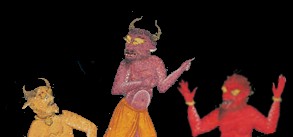
- Some families in Semnan say that in the past, people showed great respect to the Sayyid population. In return, the Sayyids were expected to be good role models. It's not clear how much these traditions are still followed today.
- Historically, people in Semnan avoided wearing black clothes for mourning the dead. This does not include religious mourning during Muharram or for Shi'a imams. This tradition might come from their dislike of the Abbasid Caliphate, which used black flags.
- Older generations in Semnan often mix superstitions with their religious beliefs. For example, in the past, local people avoided traveling near the Rig-e Jenn or Dunes of the Jinn when leading trade groups south. They believed evil spirits lived near the sand dunes.
- Traditionally, women were in charge of baking the city's oven-baked bread. It's said that in olden times, women could bake a three-month supply of bread in one day. Over time, these women created folk songs they would sing while baking, like "môr siyô" and "nün bışkán".
Muharram Traditions
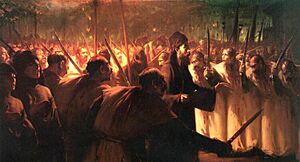
Muharram is the first month of the Islamic Calendar. It marks the sad martyrdom of the third Shi'a Imam, Imam Hussein, and 72 members of his family. People in Semnan observe Muharram and the 50 days of mourning by avoiding fun activities like music and parties. They wear dark clothes to show their grief. They also join outdoor gatherings with sad chants that remember the events of the tragedy in Karbala, where Imam Hussein was martyred.
On the tenth day of Muharram, known as Ashura, people sometimes take part in symbolic self-flagellation rituals to show their pain. Another big event in Semnan during Muharram is the reenactment of the Karbala tragedy. Locals dress up as the armies of Imam Hussein and his enemies. They also decorate horses in old cavalry uniforms to act out the battle. During these sad rituals, it's customary to cook a large community meal, usually a stew. People cook it in huge pots outdoors and take turns stirring it. Then, everyone mourning can eat it together.
Nowrouz Traditions
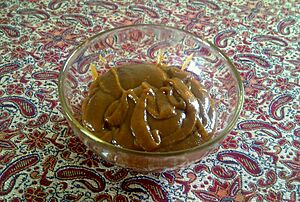
The celebrations for Nowrouz (Persian New Year) are a bit different in Semnan. Starting from the beginning of the Iranian month of Esfand, a man dressed in red with a charcoal-blackened face, known as Hajji Firuz, sits on a decorated wooden horse in the bazaars. He congratulates people and helps create a festive mood. He sings in the Semnani language: arbaab e mani somboli baleikom, arbaab e mani sarbalaayii hei kon, arbaab e mani bozboz e qandi, arbaab e mani chera nemikhandi.
As Nowrouz gets closer, many people blacken their faces with charcoal and join the celebrations. Another interesting tradition is when groups of women gather to promise God they will cook large amounts of samanu (a sweet paste) for the poor.
Semnan's Unique Foods
Semnan has many foods and dishes that are special to the city. Common ingredients in Semnani dishes include pomegranate extracts, fresh walnuts from Shahmirzad, and various greens and herbs. More recently, potatoes are also used. Semnani food tends to be a bit sour and spicy compared to the general tastes in Tehran. There's an old local saying that "Semnan has so many foods, that a wife from this city can cook a different dish for every night of the year."
Some famous dishes are Chelo Gousht, Sabzi polo, and Khoresht e Esfanaj va Gerdou. Semnani people also love different kinds of bread like shirmal, shortbread (kamôç), and Kolüçe pastries. In the Semnani language, bread baked in an oven is called "nün," while bread made in other ways is called "sôdjí."
Here are some food names in English and Semnani:
- Chicken (gırká)
- Pomegranate (nôr)
- Grapes (engír)
- Cucumber (djürüng)
- Walnut (yüz)
- Eggplant (vıngun)
- Apricot (şillık)
Semnan's Culture: Poetry and Stories
Poetry
Poetry is the most important type of literature in Semnan, especially for its cultural value. Semnani people have contributed a lot to their poetry. They use poems to share their feelings, ideas, and political views. Poetry also helps keep the native Semani language alive. Other poems are often about God and nature. Many books filled with traditional poetry have been published. Perhaps the most famous is Nanén Hıkôtí, or Mom's Sayings. Two well-known Semnani poets are Zabihullah Andaliba and Rahim Me`marian. Here's a part of a poem about Spring by Rahim Me`marian, in Semnani and English:
|
بییما فصلی بهاری... ماکره دل بیقراری The Season of Spring has arrived... It sways (the emotions) of the heart, |
Short Stories
There are many short stories in the Semnani language. Like poetry, short stories are a big part of Semnan's literature. Because the Semnani language wasn't written down much in the past, there aren't many long stories or novels. However, short stories were created to record history and entertain. These stories were passed down through generations and have now been written in books. One famous short story is "frônsé shô vu rüá," which means "(The) French King and (the) Cat."
Media in Semnan
Television
People in Semnan can watch all the national TV channels broadcast by IRIB. Semnan is also home to Semnan TV, its own provincial television station. Semnan TV has done well in making films and documentaries. One notable documentary is about the life of Ali Akbar Moallem Damghani, an Islamic scholar.
Because many different dialects are spoken in Semnan Province, Semnan TV broadcasts mostly in Persian. This is to avoid favoring one dialect over others. However, some people are upset by this policy. They worry about the Semnani language disappearing.
Radio
Like with television, Semnan receives all national radio frequencies from IRIB. Since Semnan is the provincial capital, Radio Semnan is based here and broadcasts to the whole province. Radio Semnan started in 1976. After the Islamic Revolution, it expanded greatly in 1981. This allowed for many different types of broadcasts, including religious, political, news, and cultural programs. It also increased broadcasting time to fifteen hours a day.
Today, Radio Semnan is an important source of information and discussions for the entire province. It is unique because it allows residents to call in and talk directly with city officials. This helps people share their concerns and discuss future plans.
Newspapers
Besides national newspapers like "hamshahri," Semnan publishes many of its own newspapers. It also publishes newspapers for other major cities in Semnan Province. These include:
- The daily "Payam e Ostan e Semnan" (Message of the Semnan Province)
- The weekly "Kavir" (Salt Marsh)
- The weekly "Ham Nazar" (Comments)
- The weekly "Javane ye Emrouz" (Daily Sprout)
- The weekly "Shahvar" (Kingly)
- The bi-weekly "Payam e Shahroud" (Message of Shahroud)
- The monthly "Zofor" (Victory)
- The monthly "Chafiyye" (Keffiyeh)
- The monthly "Chante" (Wallet)
- The "Journal" of the College of Anthropology of the University of Semnan
- The monthly "Healthcare Newsletter" of the Semnan Center of Health
You can also find the city's online newspaper at www.semnannews.com. The Islamic Republic News Agency also has a news outlet just for Semnan Province.
Getting Around Semnan: Transportation
Airports
Semnan has two airports: the Semnan Municipal Airport (IATA: SNX, ICAO: OIIS) and New Semnan Airport (ICAO: OI21).
Railways
The city is served by the Semnan Railway Station. It has double tracks and offers services to major cities like Tehran (to the west) and Mashad (to the east). There are also separate train services to cities within Semnan Province, such as Garmsar, Shahrud, Damghan, Meyami, and Sorkheh. The Semnan Railway Station also has modern electric train services.
Semnan also has a Semnan Municipal Train system. This train connects important points within the city, similar to light rail systems in other parts of the world.
Other Ways to Travel
Semnan has a large bus network that covers the entire city. There are also many public and private taxi services. Like most cities in Iran, Semnan has a special taxi service called "agence." This word, which comes from French, means taxis that pick you up from your home and take you directly to your destination. This is different from regular taxis that only operate on set routes.
Learning in Semnan: Higher Education
About 99% of Semnan's residents can read and write. Many people in Semnan go on to higher education. They often pursue careers in medicine, pharmacy, and high-tech engineering.
Here are some of the main centers for higher education:
- Semnan University
- Semnan University of Medical Sciences
- Gastrointestinal and Liver Diseases Research Center, Semnan University of Medical Sciences
- Islamic Azad University of Semnan
- Payame Noor University
- University of Imam Hosseyn
- University of Shaheed Abbasspour
There are also plans for a future university called the University of Industry of Semnan.
Famous People from Semnan
- Ala ud-Daula Simnani (1261-1336) - a poet
- Ashraf Jahangir Semnani (1287-1386) - a Sufi saint
- Nematollah Nassiri (1911-1979) - a security officer
- Nosratollah Noohian (born 1931) - a poet
- Shapoor Gharib (born 1933) - a film director
- Parviz Sabeti (born 1936) - a security officer
- Hassan Rouhani (born 1948) - the 7th president of Iran
- Majid Derakhshani (born 1957) - a musician
- Farhad Rahbar (born 1959) - a politician
- Ahmad Khatami (born 1960) - a politician
- Mostafa Kavakebian (born 1963) - a politician
- Mojtaba Shaban (born 1987) - a volleyball player
Images for kids
See also
 In Spanish: Semnán para niños
In Spanish: Semnán para niños


